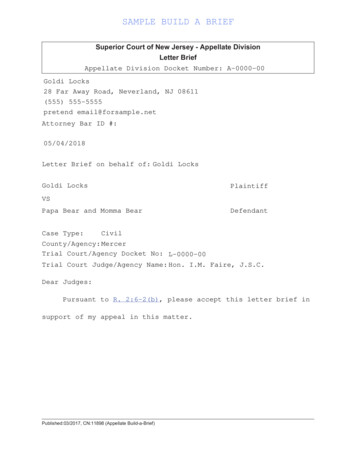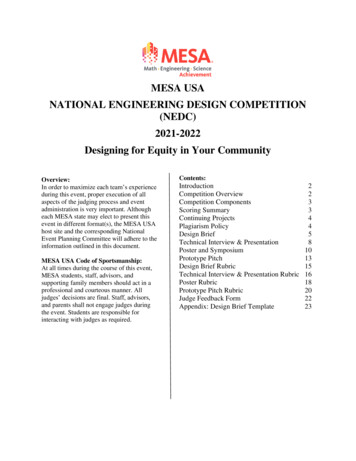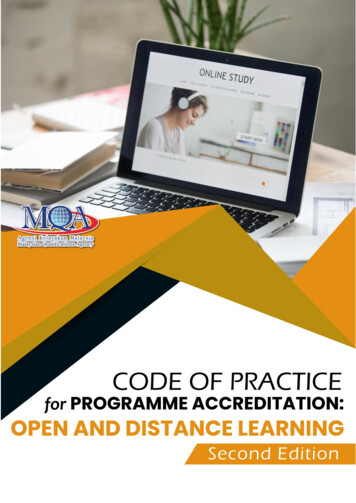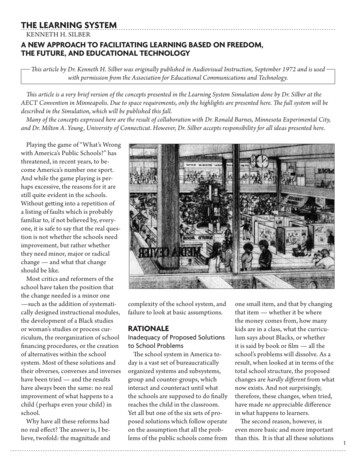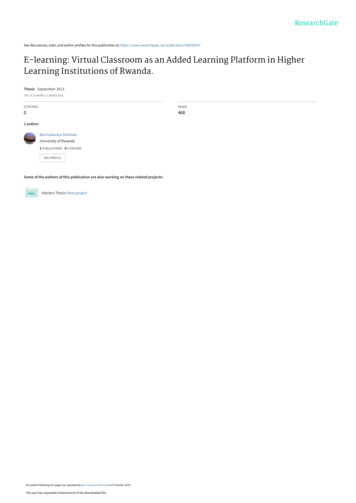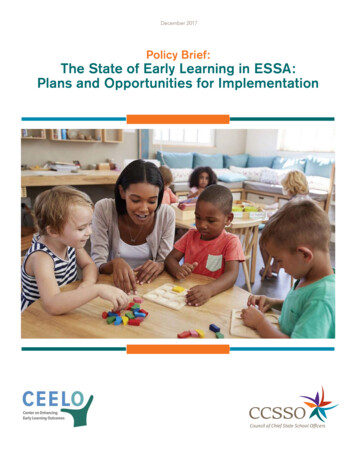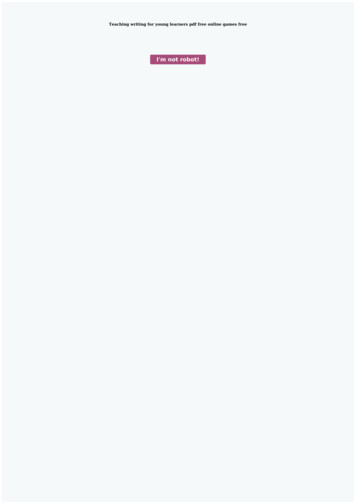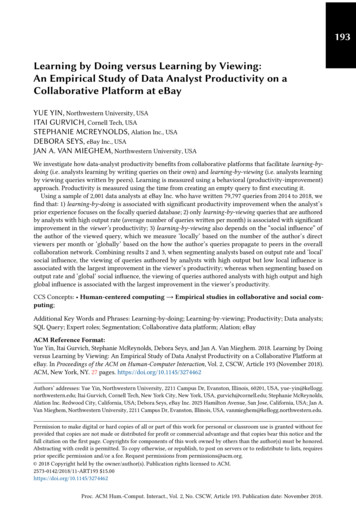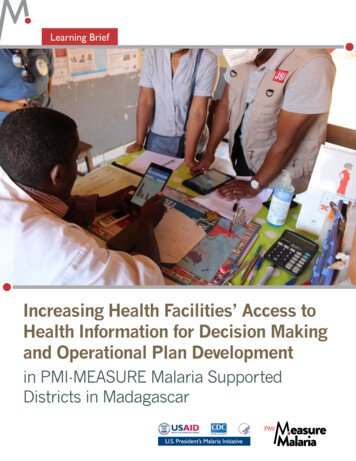
Transcription
Learning BriefIncreasing Health Facilities’ Access toHealth Information for Decision Makingand Operational Plan Developmentin PMI-MEASURE Malaria SupportedDistricts in Madagascar
WHO ARE WE?The U.S. President’s Malaria Initiative (PMI) Measure Malaria (PMM) project is funded by the United States Agencyfor International Development (USAID). Its main objective is to support strengthening of the routine healthinformation system (RHIS) and malaria surveillance, monitoring, and evaluation (SME) in the 12 USAID-supportedregions in Madagascar.Building on the lessons learned and successes of USAID’s MEASURE Evaluation project in scaling upweb-based health information models and approaches, the PMI Measure Malaria project seeks to address healthfacility access to health information by developing and implementing innovative malaria mobile dashboard andscorecard applications (apps) to empower health providers to make decisions based on evidence.WHY IS ACCESS TO MALARIA INFORMATION IMPORTANT FORHEALTH FACILITIES?Health facilities' access to malaria information isessential for the progress and sustainability of thequality of the services and data in Madagascar.Despite country support for strengthening healthinformation, access to data remains a challenge—partly because those who collect data do not alwayshave access to the appropriate tools to use it.Health facilities often report their data to districtsand do not have the capacity nor mechanisms toreview and use their own data for decision making.This lack of access can be explained by: Limited computers to store and manage dataInsufficient electricityInsufficient skilled personnel to use computersoftwareEnabling access to and visualization of keymalaria indicators at the health facility level willallow health providers to improve the quality ofservice delivery. The project used the DistrictHealth Information Software, version 2 (DHIS2)malaria module and the existence of mobileinternet networks to select key indicators ofsurveillance and service delivery at the healthfacility level to design malaria mobile-friendlydashboard and scorecard apps. The dashboarddisplays trends of the selected indicators whilethe scorecard helps monitor health facilityperformance. The DHIS2-based mobile apps aresupported on Android devices and data areaccessible both onlineand offline.Lack of access to land line internetAvailability of infrastructure and equipmentin a sample of 39 health facilities31% of health facilities have electricity3% of health facilities have computers5% of health facilities have internet95% of health facilities have tablets54% of health facilities have smartphonesData source: Evaluation of the use of mobile applications2
KEY ACTIVITIES LEADING TO INCREASED PARTICIPATION ANDOWNERSHIP TO IMPLEMENTATING MALARIA MOBILE APPSThe implementation process of the mobile dashboard and scorecard apps required joint efforts from partners tosupport the Madagascar National Malaria Control Program (NMCP) in increasing access to malaria informationfor all health facilities. Processes for the development and implementation of the mobile dashboard andscorecard apps consisted of: Developing generic mobile apps with a selection of WHO key malaria surveillance indicators.Reviewing and adapting to country malaria surveillance information needs by the NMCP and its partners.Using existing district coordination meetings to train and guide health facility providers on the use of themobile apps for data analysis and development of plans of action.Monitoring the use of the mobile apps and the progress made toward addressing the plans of actionAs a result of this process, the pilot phase was implemented in the district of Toliara 2 in August 2021 for 42health facilities with tablets and access to the mobile internet network. All service providers from the healthfacilities are invited at the end of each quarter to routine district coordination meetings to discuss and addresstheir respective health service issues. This platform was used to train health providers on the use, and to reviewwith them the results, of mobile dashboard and scorecard apps installed on their tablets. During these meetings,each facility’s plan of action was reviewed and updated based on the results of the mobile apps and on progressmade in implementing previous recommendations.How Health Facility Managers Perceived the Use of Malaria Mobile AppsDistrict of Toliara 2Among the 39 health facilities assessed during the first quarter ofimplementation, 27 health facilities in Toliara 2 were trained on use ofthe malaria mobile apps, with 12 non-trained health facilities fromother districts used as the control group. After only three months usingthe mobile apps, 63% of the trained health facility managers found thatthe selected indicators in the graphs and tables were well visualized interms of the trends of malaria cases and the service performance level.After six months using the mobile apps, the two quarterly visits revealedan increase, from 48% to 72%, of malaria scorecard app users andfrom 37% to 51% of malaria dashboard mobile app users who foundgraph and table presentations immediately identifying the problemsand felt they were very easy to interpret.Of the 42 health facilities trained on the use of mobile malaria apps, 27health facilities were visited in the first quarter and 39 in the secondquarter to assess their use. The health facility managers’ perceptionson the use of the malaria mobile apps increased from 26% to 80% fortheir contribution toward monitoring the levels of commodity stock, andfrom 44% to 62% for their help in improving decision making. However,four percent had not used the app because they could not download itdue to having older tablets or no access to the internet.Even though the mobile apps have been very useful, the fact remainsthat users would like to view the scorecard tables on one page. Theyalso expressed the need to access the apps with a newer Androidversion and to have a fast internet connection.One health facility manager stated“ The applications have improved ourwork, because with hard copy of themonthly report we have to go throughpaper reports to explore past data,whereas with the applications weimmediately access data from the last12 months.”Another said that “ the applicationsare a reminder tool for me, in case I amdrowned in other routine activities,using the applications I can determinethe status of the HF indicators”According to a health facility manager:"The individual presentation of the databy HF would be better, instead ofcombining the data of all the HF on thesame graph, because we tend tocompare several HFs which havedifferent targeted populations.”Another said: “Presenting individual HFdata allows us to focus more on ourperformance.”3
The District Manager’s Role in Encouraging theUse of Malaria Mobile Apps to Address ServicePerformance IssuesWhen asked about their role in encouraging the use of malariamobile apps, one district manager responded: “We work closelywith health facilities to help them understand the indicators andtheir differences in scorecard and dashboard. It is the districtmanager’s responsibility to explain the indicators to the healthfacility that some of the misunderstood indicator results are notalways data entry errors but could be service provision underperformance.”“At the end of each month, we tell them not to forget to use thescorecard and dashboard to update the action plan template. Toencourage continued use of the mobile applications, we alsoadvise them to delete photos and videos since their tabletstorage capacity is low which prevents the malaria mobileapplication from working.”A Health Facility Manager’s Understanding of theDistrict Management Team’s Role in Overseeingthe Use of Mobile AppsOne health facility manager stated: “The district managers areguiding health facilities in the use of the malaria scorecard anddashboard applications. It is during the monthly review that thedistrict management team encourages health facility managersto develop an action plan on the results of the dashboard andthe scorecard applications.”Top photo: Toliara 2 district coordination meeting to review malaria dataquality and use, August 2021. Bottom photo: Training on use of malariamobile scorecard and dashboard apps at Antsirabe 2 district, February2022. Photos courtesy of PMI Measure Malaria Madagascar.USE OF MALARIA MOBILE APPS AT HEALTH FACILITIES INCREASEDREAL-TIME ACTIONS IN PROBLEM SOLVINGThe health facilities’ ability to monitor performance and trend progress and to develop/updateplans of action in three consecutive assessments of mobile app use were as follows:55%October 202167%79%November 2021February 2022The first follow-up was made by phone call, where, out of the 42 health facilities, 14 were notreached and 12 were not able to use the mobile apps due to the lack of internet access or wereunable to download graphs and tables because of older versions of tablets. Following theFebruary 2022 visit, the district used the assessment results to advocate for the purchase of newtablets and WHO provided new devices running Android version 10 and internet airtime to allowhealth facilities to download graphs and tables for use in the mobile apps.4
Improvement of Malaria ServiceDelivery and CommodityManagementDevelopment of Health FacilityPlans of Action Based on the Resultsof Malaria Mobile AppsDuring an August 2021 Toliara 2 districtcoordination meeting, health facility managers weretrained on the use of malaria mobile apps. Afterinstallation of the malaria mobile apps on the healthfacilities’ tablets, the first review of each healthfacility’s data was followed by development of plansof action. The results of the November 2021assessment on the use of the malaria mobile appsin a sample of 27 health facilities in the district ofToliara 2, showed only 89% found issues whichrequired the development of a plan of action. Amongthe health facilities with plans of action, only 75%were available during the day of the assessmentvisit and 50% of the available plans were monitoredand updated. The limited availability of high-speedinternet and the use of older tablets did not allowthe other half of the health facilities to monitorprogress and update their recommendations.Expanded real-time access to malaria informationfor use in health facilities offers malaria serviceproviders the opportunity to discuss and addressservice delivery and commodity management issuesand performance during their meetings withcommunity leaders and community health workersat the health facility level. The November 2021assessment and the February 2022 monitoring ofthe use of malaria mobile apps revealed an increaseof users’ appreciation from 52% to 66% forimproved performance of malaria service deliveryand from 63% to 80% for improved malariacommodity management. The progress made in theimplementation of each health facility’s plan ofaction is monitored and malaria mobile app trendsand score performance are reviewed during thequarterly district coordination meetings.Progress from Implementation of the Plans of Action RecommendationsFollowing the use of the malaria mobile scorecard and malaria dashboard apps, and the implementation of theplans of action, considerable progress toward improving the performance of health facility services wasobserved. Results from the 13 health facilities with updated plans of action showed that all had observeddecreases in malaria positivity rates following recommendations to intensify awareness-raising activities onmalaria preventive measures and the distribution of long-lasting insecticide-treated nets (LLINs), and only twohealth facilities presented poor performance in the proportion of pregnant women with IPT3.Health facilityCSB2 AmbohimahavelonaCSB2 BerorohaLow performance indicatorMalaria positive rate with RDT for children under 5yearsMosquito net distributed to children under 1 yearfully immunizedNumber of malaria cases for 6 to 13 yearsProportion of pregnant women with IPT3CSB1 ManorokaProportion of pregnant women with IPT3CSB 1 AntanimenaCSB Mitsinjo BetanimenaBaselineAug. B MarofotyProportion of pregnant women with IPT340%63%55%-8%CSB Saint AugustinACT availability rate for 14 years and more85%80%100%20%CSB2 Manombo sudCSB2 MiaryRoutine mosquito net availability rateMalaria positive rate with RDT0%66%67%70%89%11%22%-59%CSB ANDREVO BASMalaria positive rate with RDT50%45%23%-22%CSB MANOROFIFYMalaria positive rate with RDT60%50%30%-20%CSB2 MaromiandraMalaria positive rate with RDT50%42%11%-31%CSB TSIHAKYMalaria positive rate with RDT for 6 to 13 years32%33%0%-33%5
Quarterly District Coordination Meetings are a Sustainable Platform to Reviewthe Results of Malaria Mobile Apps and to Exchange Best PracticesTo promote routine malaria information use, the existing platform within the Ministry of Health constitutes thebest approach to sustain the activity. At the operational level, the health district organizes quarterly meetings todiscuss health service delivery and conduct paper-based data monitoring. The introduction of malaria web andmobile apps enabled real-time access to malaria information and development of plans of action for eachhealth facility. Returning to their health facilities, managers presented their performance and plans of action tothe community leaders and health workers for implementation of the recommendations.ToT for NMCP and HIS staff on use of malaria mobile scorecard and dashboard apps at Antananarivo, June 2021. Photo courtesy of PMI Measure Malaria Madagascar.CHALLENGES FOR THE USE OF MALARIA MOBILE APPS IN IMPROVINGACCESS TO MALARIA INFORMATION IN HEALTH FACILITIESBetween some tablets running older versions of the Android operating system (5.0 or earlier) and limitedinternet access, most of the health facilities in the district of Toliara 2 were unable to download thedashboard graphs and scorecard tables. During the district meetings, where high-speed internet wasavailable, these health facilities managed to download the graphs and tables to develop their plans ofaction. However, once back at their health facilities, they did not access the new graphs and tables due toslow internet speeds and outdated tablets. The NMCP and the district presented results from theNovember 2021 and February 2022 assessments of malaria mobile app use to partners to advocate forsupport. In March 2022, WHO purchased tablets running Android version 10 and internet connectivity forthe 42 health facilities of the district; other partners are upgrading the slower speed internet plans to highspeed. The Ministry of Health is planning to provide new versions of tablets to other districts to scale-upthe use of malaria mobile apps. The Global Fund has also promised to fund scale-up for the use of malariamobile apps in non-USAID supported regions.6
The Way Forward for Sustainable Use of Malaria Mobile Apps to Enable Access toMalaria Information by Health Facilities for Decision MakingThe scale-up of malaria mobile apps is dependent on increased access to high-speed mobile internet and theavailability of newer versions of tablets and smartphones. District coordination meetings gathering both healthfacility managers and partners are the best platforms to review real-time malaria data and to monitor and addressrecommendations based on evidence. Instead of relying on paper-based data—which may be affected by errors orbiases—to calculate indicators, the use of malaria mobile apps will help to rationalize the data review meetingsand to reduce errors from manual indicator calculations. Malaria mobile apps will also increase health providers’accountability in terms of their own service delivery performance.Training on the use of malaria scorecard and dashboard apps at Antsirabe 2 district in Madagascar, February 2022. Photo courtesy of PMI MeasureMalaria MadagascarThis information was made possible by the generous support of the American people through the United States Agency for InternationalDevelopment (USAID) and the U.S. President’s Malaria Initiative (PMI) under the terms of the PMI Measure Malaria Associate Award No.7200AA19LA00001. PMI Measure Malaria is implemented by the University of North Carolina at Chapel Hill, in partnership with ICF Macro, Inc.;Tulane University; John Snow, Inc.; and Palladium International, LLC. The contents do not necessarily reflect the views of USAID/PMI or theUnited States Government. FS-22-569 PMI. Cover photo: Evaluation of the use of malaria mobile scorecard and dashboard apps at HF in District ofToliara 2, November 2021, courtesy of PMI Measure Malaria Madagascar.
United States Government. FS -22-569 PMI. Cover photo: Evaluation of the use of malaria mobile scorecard and dashboard apps at HF in District of Toliara2, November 2021, courtesy of PMI Measure Malaria Madagascar. Training on the use of malaria scorecard and dashboard apps at Antsirabe 2 district in Madagascar, February 2022.

